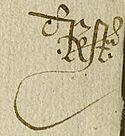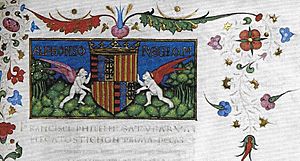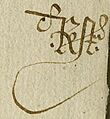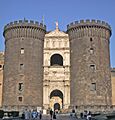Alfonso V of Aragon facts for kids
Quick facts for kids Alfonso V |
|
|---|---|

Alfonso as a Knight of the Golden Fleece
Miniature from the southern Netherlands, 1473 |
|
| King of Aragon | |
| Reign | 2 April 1416 – 27 June 1458 |
| Predecessor | Ferdinand I |
| Successor | John II |
| King of Naples | |
| Reign | 2 June 1442 – 27 June 1458 |
| Predecessor | René |
| Successor | Ferdinand I |
| Born | 1396 Medina del Campo, Kingdom of Castile |
| Died | 27 June 1458 (aged 61–62) Castel dell'Ovo, Naples, Kingdom of Naples |
| Burial | Poblet Monastery |
| Spouse | |
| Issue among others... |
Ferdinand I of Naples |
| House | Trastámara |
| Father | Ferdinand I of Aragon |
| Mother | Eleanor of Alburquerque |
| Signature |  |
Alfonso the Magnanimous (born 1396, died 27 June 1458) was a powerful European king. He was known as Alfons el Magnànim in Catalan. Alfonso ruled the Crown of Aragon from 1416. This included the kingdoms of Aragon and Sicily. Later, he also became King of Naples in 1442.
Alfonso spent many years fighting for control of the Kingdom of Naples. He eventually won and was crowned king there. He also had good relationships with allies like Skanderbeg in the Balkans. Alfonso was an important figure in the early Renaissance. He loved literature and supported many building projects, like the Castel Nuovo in Naples.
Contents
Becoming King: Alfonso's Early Life
Alfonso was born in Medina del Campo. His father was Ferdinand of Trastámara. His mother was Eleanor of Alburquerque. In 1408, Alfonso was promised in marriage to Maria of Castile. She was the daughter of his uncle, King Henry III of Castile.
In 1412, Alfonso's father, Ferdinand, was chosen to rule the lands of the Crown of Aragon. Alfonso and Maria were married in Valencia on 12 June 1415.
King Ferdinand died on 2 April 1416. Alfonso then became king of Aragon, Valencia, and Majorca. He also became the Count of Barcelona. He claimed the island of Sardinia and controlled much of Corsica.
Alfonso and Maria did not have children together. However, Alfonso had a son named Ferdinand. This son later became King of Naples.
Alfonso also had contacts with the Ethiopian Empire. In 1428, he received a letter from Yeshaq I of Ethiopia. The letter suggested an alliance against Muslim forces. It also proposed a marriage between Alfonso's brother and Yeshaq's daughter. Alfonso sent craftsmen to Ethiopia, but they did not arrive safely. He later tried to send more artisans, but it is unclear if his message reached the new Ethiopian ruler.
Fighting for Naples: A Long Struggle
In 1421, Queen Joanna II of Naples had no children. She adopted Alfonso and named him as her heir. Alfonso traveled to Naples to take control. He hired a condottiero, a hired military leader, named Braccio da Montone. Braccio helped Alfonso fight against his rival, Louis III of Anjou.
Alfonso's relationship with Queen Joanna soon became difficult. In 1423, Alfonso tried to arrest her powerful advisor. This made Joanna angry. She then changed her mind and named Louis III as her new heir.
Alfonso had to leave Naples and sail to Spain. A war had started there involving his brothers. On his way, Alfonso attacked Marseille, a city belonging to Louis III.
In 1423, a fleet from Genoa attacked Alfonso's forces in Naples. Naples fell in April 1424. Alfonso's brother, Pedro, fled to Sicily. Joanna II and Louis III took control of Naples again.
Alfonso saw another chance to take Naples in 1432. Both Louis and Joanna died in 1434 and 1435. Joanna's will named René of Anjou, Louis III's younger brother, as her heir. Alfonso disagreed with this. He attacked the city of Gaeta. However, in the Battle of Ponza, Alfonso was defeated and captured.
While a prisoner in Milan, Alfonso impressed his captor. He convinced him that it was better for Milan if he was released. Alfonso was set free and, with help from Sicily, he recaptured Gaeta in 1436.
René of Anjou arrived in Naples in 1438. Alfonso tried to besiege Naples but failed. His brother Pedro was killed during this battle. However, René's luck began to change. Alfonso captured many cities, including Aversa and Salerno.
Alfonso then laid siege to Naples again on 10 November 1441. The siege ended on 2 June 1442. René returned to France. Alfonso easily took control of the remaining areas. He made a grand entrance into Naples on 26 February 1443. He was now the king of a peaceful kingdom.
Alfonso then brought the kingdoms of Naples and Sicily back together. They had been separated for a long time. He called himself Rex Utriusque Siciliae, meaning "King of Both Sicilies."
Art and Government: Alfonso's Legacy
Like many rulers during the Renaissance, Alfonso V supported the arts. He started the Academy of Naples. For his grand entrance into Naples in 1443, he added a beautiful triumphal arch to the main gate of Castel Nuovo.
Alfonso especially loved classical literature. He reportedly carried books by Livy and Julius Caesar during his military campaigns. One poet even claimed that reading a book about Alexander the Great helped Alfonso recover from an illness.
After taking Naples in 1442, Alfonso ruled mainly through his hired soldiers and loyal officials. He kept the existing government systems in his Italian kingdom. His lands in Spain were managed by his wife, Maria.
Alfonso also made improvements in his kingdom. He restored water systems and paved streets. He also founded the first university in Sicily, the Siciliae Studium Generale.
Later Life and Alliances
Alfonso was a strong supporter of Skanderbeg, an Albanian leader. In 1451, Alfonso promised to protect Skanderbeg as a vassal. He gave Skanderbeg money, military equipment, and a safe place for his family if needed. This was because Skanderbeg had helped Alfonso defeat rebellious nobles in Naples in 1448.
Alfonso also supported Stjepan Vukčić Kosača, a Bosnian duke. Stjepan asked Alfonso for help in Bosnia. Alfonso made him a "Knight of the Virgin" but did not send troops. In 1444, Stjepan signed a treaty with Alfonso. He became Alfonso's vassal in exchange for help against his enemies. Stjepan also promised to pay tribute to Alfonso instead of the Ottoman sultan.
Alfonso wanted his son, Ferdinand, to inherit the Kingdom of Naples. He got permission from Pope Eugene IV for this. Alfonso died in Castel dell'Ovo in 1458. At the time, he was planning to conquer Genoa. His brother, John II of Aragon, inherited his lands in Spain, Sicily, and Sardinia.
See also
 In Spanish: Alfonso V de Aragón para niños
In Spanish: Alfonso V de Aragón para niños
Images for kids







